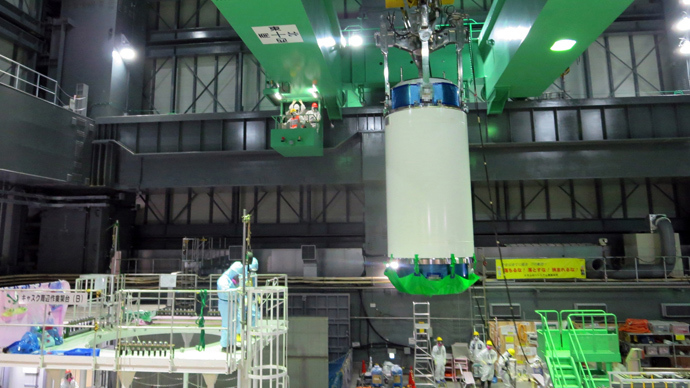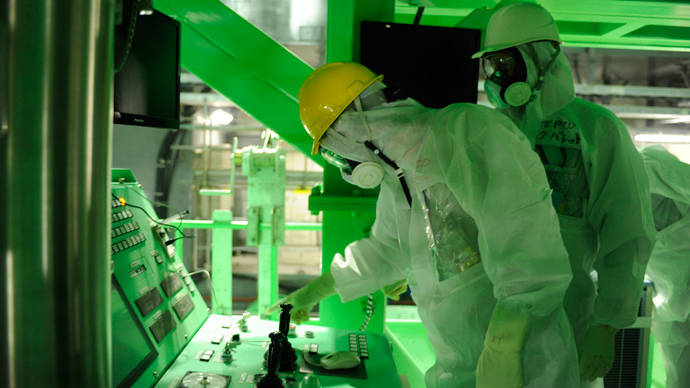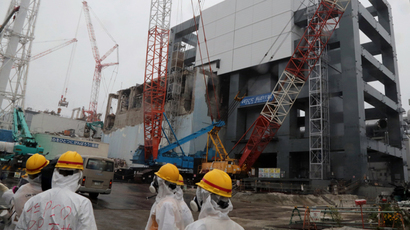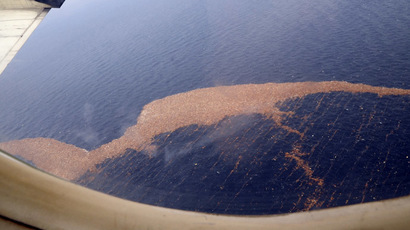Fukushima operators begin risky nuclear fuel rod removal

In a highly risky undertaking Fukushima plant operators have finally begun removing over 1,500 nuclear fuel rods from one of the four reactors at its damaged nuclear power plant in northeastern Japan on Monday.
During the first transfers of the operation, steel fuel
rods were laid in a cooling pool in a damaged reactor building.
The portable pool holds 22 rods, with the operation being likened
to removing cigarettes from a squashed pack. While the first
group will take around two days to move, it could take up to a
week to move the cooling pool to a common storage pool in a
different building, TEPCO told Reuters. "We will
continue with the work from tomorrow and proceed, paying close
attention to safety," said TEPCO in the statement.
It is important to conduct the transfer as soon as possible as
they are being stored in an unstable building which could
potentially collapse in the event of another earthquake.
Unit 4 of the Fukushima Daiichi plant was offline at the time of
the 2011 catastrophic earthquake and tsunami, which is why,
unlike the other three, its core didn't go into meltdown.
Hydrogen explosions blew the roof off the building and severely
damaged the structure, however. Keeping so many fuel rods in a
storage pool in the building poses a serious safety risk, experts
say.
With the help of robots and cranes, the workers will attempt to
cautiously transfer 1,331 spent fuel rods and 202 new ones from
the damaged reactor pool to a more reliable storage facility. If
these rods break or overheat, radioactive gases could be released
into the atmosphere, however, prompting a self-sustained nuclear
chain reaction.
According to the operators of the plant, Tokyo Electric Power Co
(TEPCO), all necessary measures have been taken to contain the
threat stemming from the worst nuclear disaster since Chernobyl.
While the full decommissioning of the plant is expected to take
decades, the company said it plans to remove 22 rods over the
course of two days. A giant crane equipped with a remote-
controlled pincer will be lowered into the pool and hook onto the
rods, placing them inside a 91-ton cask which will be loaded on
to a trailer and taken to a new storage pool.
Earlier this week it was reported that three of the spent fuel
assemblies that will be pulled from the nuclear plant on Monday
were in fact damaged before the 2011 earthquake hit the facility.
TEPCO said the damaged assemblies - 4.5 meter high racks with 50
to 70 rods of highly irradiated used fuel - wouldn’t be lifted
from the plant’s Reactor No. 4, Reuters reported.
In an 11-page information sheet released in August, TEPCO
informed that one of the assemblies was actually damaged back in
1982, when it was bent out of shape during a transfer.
Japan’s Nuclear Regulation Authority has assigned an inspector to
keep an eye on the dangerous operation, as well as video
monitoring of the removal site.
Meanwhile, targets for reducing radiation levels and eradicating
nuclear fallout in the areas still haven't been met, with the
radius of evacuation after the Fukushima nuclear meltdown larger
than the area of Hong Kong. Some areas will remain contaminated
for years to come, experts say. Part of the cleanup plan is to
decontaminate the surrounding towns and villages and follow new
guidelines by the International Center for Radiological
Protection.

Major setbacks have stalled TEPCO's handling of the crisis amid
widespread criticism. The utility was scheduled to begin the
clean-up operation earlier this month which had to be put off
after the Japan Nuclear Energy Safety Organization pressed for
further safety checks.
A recent special investigation by Reuters has revealed the
distressing conditions of working at the
crippled Fukushima Daiichi plant, which are aggravated by very
low pay and questionable attitudes to workers’ rights by
sub-contractors involved in the numerous projects.
TEPCO is in the process of decommissioning the entire six-reactor
Fukushima Daiichi plant after three reactors suffered core
meltdowns in March 2011. Moving the fuel assemblies in Reactor
No. 4 remains the top priority, as their height above ground
appears to be highly vulnerable to another earthquake.














